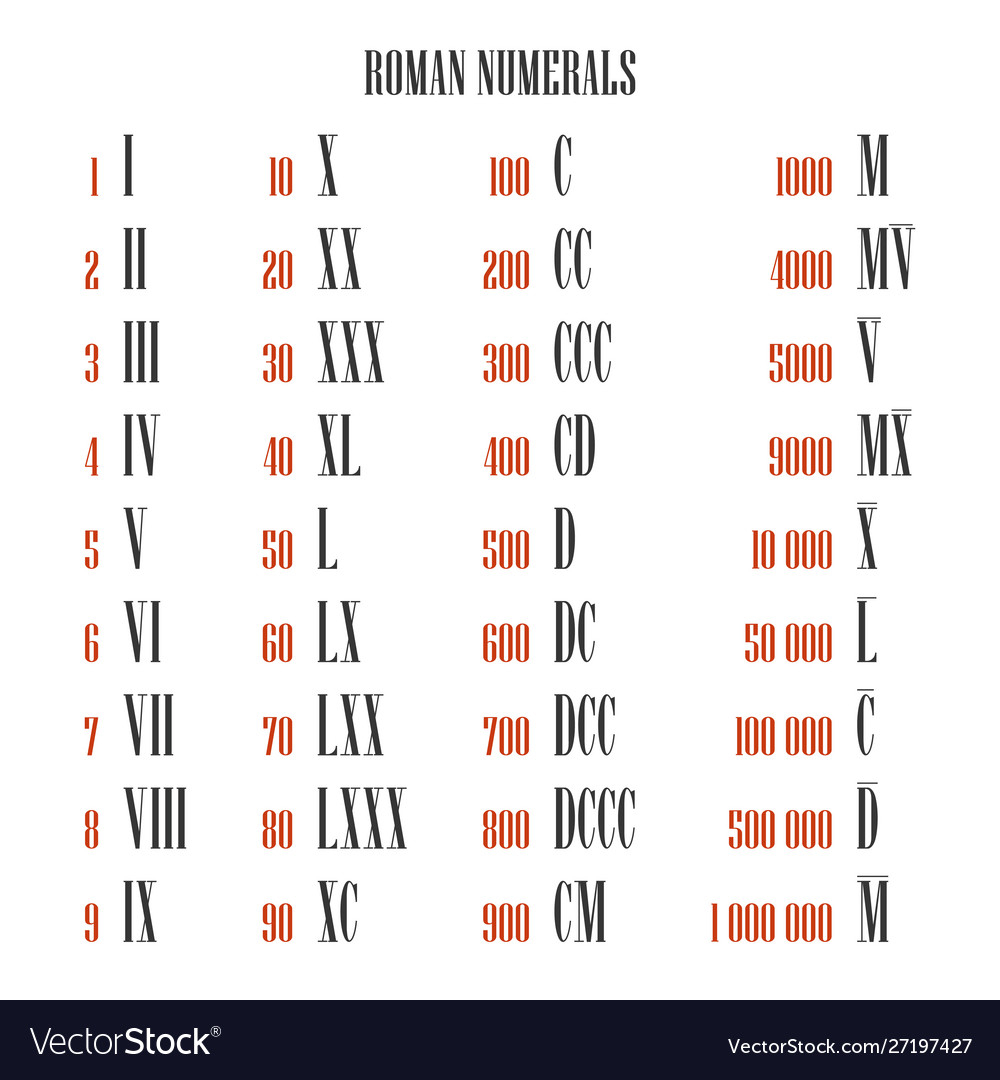Roman numeral XCX has long fascinated historians, mathematicians, and enthusiasts alike. The Roman numeral system, a numeral system originating from ancient Rome, remains relevant even in today's modern world. This system uses combinations of letters from the Latin alphabet to represent numbers, and XCX is one such fascinating example. By exploring the intricacies of XCX, we can gain a deeper understanding of how this ancient system functions.
Roman numerals are not only a part of history but also play a significant role in modern-day applications. From clocks to chapter titles in books, Roman numerals continue to be used widely. Understanding XCX and its place within the Roman numeral system provides valuable insights into the logic and structure of this ancient counting method.
This article delves into the intricacies of Roman numeral XCX, exploring its historical significance, mathematical representation, and practical applications. Whether you're a student, a history enthusiast, or simply curious about numbers, this guide will provide you with a comprehensive understanding of XCX and its relevance in both historical and contemporary contexts.
Read also:Post Malone Height The Truth Behind The Rappers Stature
Table of Contents
- The History of Roman Numerals
- Structure of Roman Numerals
- What Does XCX Mean?
- How to Calculate XCX
- Common Variations of XCX
- Applications of XCX in Modern Times
- Mathematical Operations with XCX
- Historical Significance of XCX
- Tips for Understanding Roman Numerals
- The Future of Roman Numerals
The History of Roman Numerals
Roman numerals have a rich history that dates back to ancient Rome. The system was developed as a means of counting and recording numbers in a society that lacked a formalized numerical system. Initially, the Romans used tally marks and other rudimentary methods, but as their civilization advanced, so did their numerical system.
The Roman numeral system emerged around the 6th century BC and became the standard method of numerical representation throughout the Roman Empire. It was widely used in commerce, construction, and even in the military. Over time, the system evolved, incorporating new symbols and rules to accommodate larger numbers.
Early Usage and Development
Early Roman numerals were simpler, using only a few basic symbols such as I, V, and X. As the need for more complex numbers grew, additional symbols like L, C, D, and M were introduced. This expansion allowed the Romans to represent larger numbers with greater precision, enabling them to perform more advanced calculations.
Today, Roman numerals remain an integral part of our cultural heritage, appearing in various contexts such as movie credits, clock faces, and architectural inscriptions. Their enduring presence is a testament to the ingenuity of the ancient Romans and the lasting impact of their contributions to mathematics and numeracy.
Structure of Roman Numerals
The Roman numeral system is based on a combination of seven primary symbols: I, V, X, L, C, D, and M. Each symbol represents a specific value, and numbers are formed by combining these symbols according to specific rules. The structure of Roman numerals relies on both addition and subtraction principles, making it a unique and versatile system.
Basic Symbols and Their Values
- I = 1
- V = 5
- X = 10
- L = 50
- C = 100
- D = 500
- M = 1000
Understanding the basic symbols and their values is essential for deciphering Roman numerals. By combining these symbols, larger numbers can be represented with relative ease. For example, the numeral IX represents 9, using the subtraction principle (10 - 1), while XV represents 15, using the addition principle (10 + 5).
Read also:Ximena Saenz Leaks Exploring The Truth Behind The Controversy
What Does XCX Mean?
Roman numeral XCX represents the number 90. This numeral is formed by combining the symbols X (10) and C (100) using the subtraction principle. In this case, X is placed before C, indicating that 10 should be subtracted from 100, resulting in 90. This principle is a fundamental aspect of the Roman numeral system and is used extensively to represent numbers efficiently.
XCX is a unique example of how the Roman numeral system utilizes both addition and subtraction to create concise and meaningful representations of numbers. Its simplicity and elegance make it a fascinating subject for study and exploration.
How to Calculate XCX
Calculating XCX involves applying the basic principles of the Roman numeral system. To determine the value of XCX, we start by identifying the individual symbols and their respective values:
- X = 10
- C = 100
Next, we apply the subtraction principle, which states that when a smaller numeral precedes a larger numeral, it should be subtracted from the larger numeral. In the case of XCX, X is placed before C, so we subtract 10 from 100, resulting in 90.
This method of calculation is straightforward and highlights the logical structure of the Roman numeral system. By mastering these principles, anyone can accurately interpret and calculate Roman numerals.
Common Variations of XCX
While XCX is the standard representation of 90 in the Roman numeral system, there are occasional variations that may appear in historical texts or modern applications. These variations often arise due to differences in regional practices or stylistic preferences.
Alternative Forms of XCX
- XC: This is the most common variation of XCX and is widely accepted as the standard representation of 90.
- LXXXX: This form uses the addition principle, adding four X symbols (10 + 10 + 10 + 10) to represent 90. While less common, it is still a valid representation.
Understanding these variations is important for accurately interpreting Roman numerals in different contexts. By recognizing the rules and principles that govern these variations, we can ensure consistency and accuracy in our calculations.
Applications of XCX in Modern Times
Despite the widespread adoption of the Arabic numeral system, Roman numerals like XCX continue to find applications in various fields. From architecture to entertainment, Roman numerals add a touch of elegance and tradition to modern designs and communications.
Modern Usage of XCX
- Clock Faces: Many analog clocks use Roman numerals to mark the hours, with XCX often appearing as a stylistic choice for the 9th hour.
- Book Chapters: Roman numerals are frequently used to number chapters in books, especially in classic literature and academic texts.
- Monuments and Inscriptions: Historical monuments and architectural inscriptions often feature Roman numerals, including XCX, to denote dates or significant events.
These applications demonstrate the enduring relevance of Roman numerals in contemporary society, highlighting their versatility and cultural significance.
Mathematical Operations with XCX
Roman numerals like XCX can be used in various mathematical operations, including addition, subtraction, multiplication, and division. While these operations may require additional steps compared to the Arabic numeral system, they are still possible and can be performed with practice and understanding.
Examples of Mathematical Operations
- Addition: XCX + X = C
- Subtraction: C - X = XCX
- Multiplication: XCX × X = CM
- Division: C ÷ X = X
These examples illustrate the practical applications of Roman numerals in mathematical calculations. By mastering these operations, individuals can expand their understanding of the Roman numeral system and its capabilities.
Historical Significance of XCX
The historical significance of XCX lies in its role as a representation of the number 90 in the Roman numeral system. Throughout history, XCX has been used in various contexts, from recording dates and events to marking architectural structures and inscriptions. Its presence in historical documents and artifacts provides valuable insights into the numerical systems and practices of ancient civilizations.
XCX also serves as a reminder of the ingenuity and adaptability of the Roman numeral system, which has endured for centuries despite the advent of more modern numerical systems. Its continued use in contemporary applications underscores its timeless appeal and relevance.
Tips for Understanding Roman Numerals
Mastering Roman numerals like XCX requires practice and familiarity with the system's rules and principles. Here are some tips to help you improve your understanding and proficiency:
- Learn the basic symbols and their values.
- Understand the addition and subtraction principles.
- Practice converting Roman numerals to Arabic numerals and vice versa.
- Study historical examples and applications of Roman numerals.
By following these tips, you can enhance your knowledge of Roman numerals and develop a deeper appreciation for this ancient system.
The Future of Roman Numerals
While the Roman numeral system may not be as widely used as the Arabic numeral system, it remains an important part of our cultural heritage. Its continued presence in modern applications, such as clocks, book chapters, and architectural inscriptions, ensures its relevance in contemporary society.
As technology advances and new methods of communication emerge, the future of Roman numerals may evolve to accommodate changing needs and preferences. However, their historical significance and cultural value will undoubtedly ensure their place in the annals of human history.
Conclusion
Roman numeral XCX represents a fascinating example of the Roman numeral system's logic and structure. By exploring its historical significance, mathematical applications, and modern-day usage, we gain a deeper understanding of this ancient system and its enduring relevance. Whether used in clocks, book chapters, or architectural inscriptions, Roman numerals like XCX continue to captivate and inspire.
We encourage readers to share their thoughts and insights in the comments section below. Additionally, feel free to explore other articles on our site for more information on Roman numerals and related topics. Together, let's celebrate the rich history and cultural significance of this remarkable numeral system.
Sources:
- https://www.britannica.com/topic/Roman-numeral
- https://www.mathsisfun.com/roman-numerals.html
- https://www.history.com/topics/ancient-rome/roman-numerals


